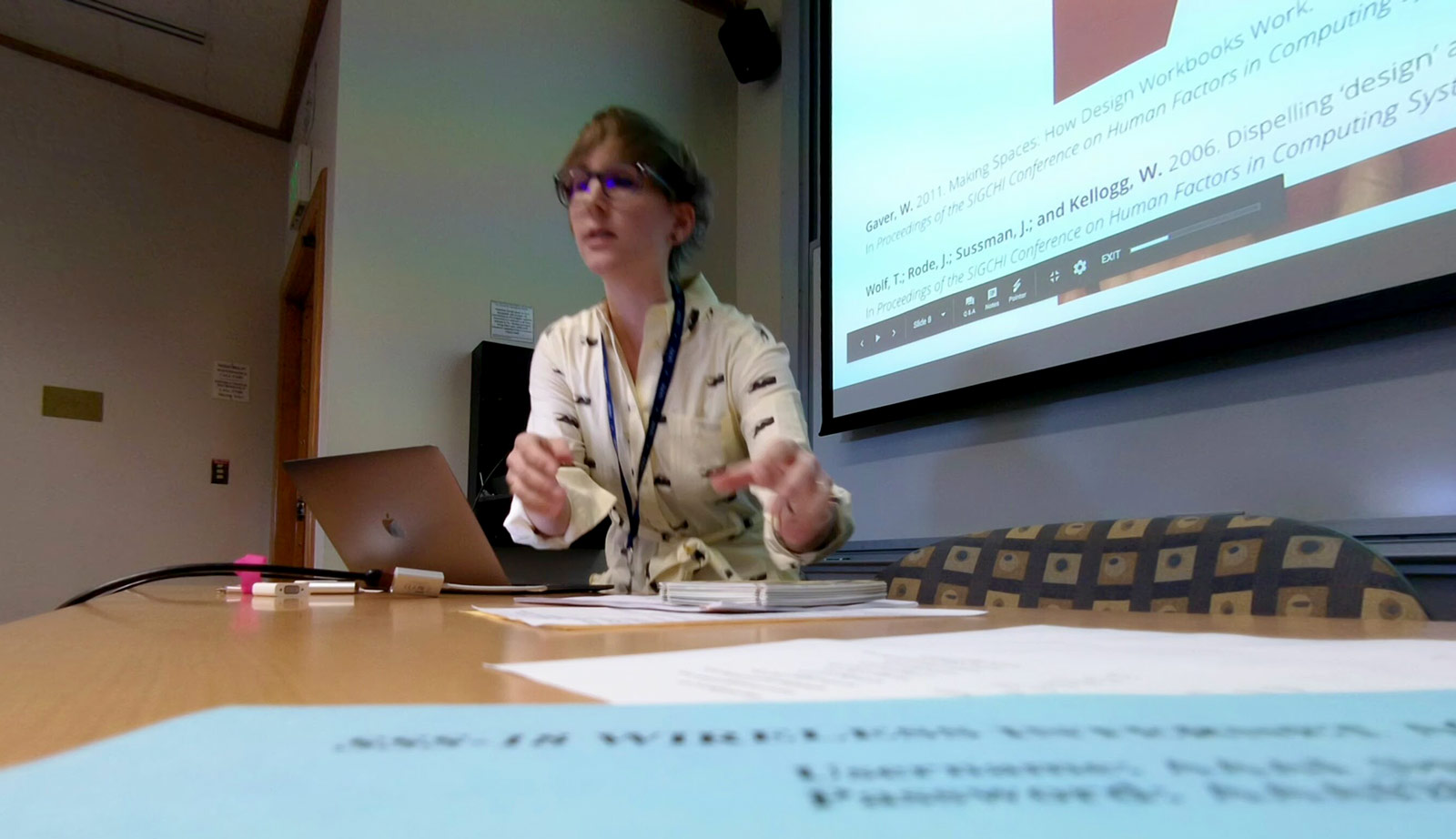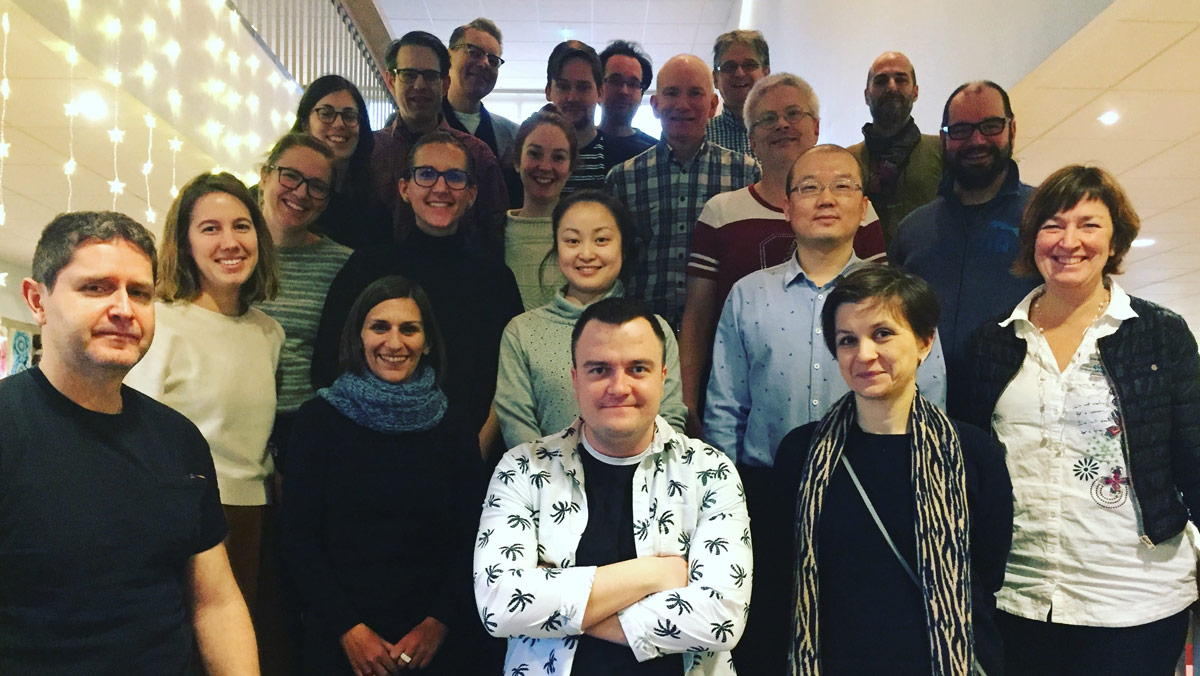Category: Arduino
AAAI 2018 – Presentation & Slides

Last week I presented my paper Design Methods to Investigate User Experiences of Artificial Intelligence at the 2018 AAAI Spring Symposium on the User Experiences of Artificial Intelligence. The picture above was taken by a Google Clips camera, which was also one of the presented papers. Below are my slides, which contain supplementary images to my paper on the three design methods I have engaged with relative to the UX of AI. Another blog post will soon follow with reflections on other papers presented.
PhD’ing – Writers’ Retreat, Project Offsite, Outdoors Research, and Making Preciousness
Today I saw a meme on Instagram which said, “We are now entering the third month of January.” I couldn’t relate more! And looking back over the past few weeks, cannot believe all that has already happened in 2018.

Writer’s Retreat
Following a paper deadline in early January, my department at KTH (Media Technology and Interaction Design) kicked off 2018 with a writers’ retreat. What happens at a writers’ retreat? We book a venue in the Stockholm archipelago for three days and two nights, and write. And sauna and winter swim, but mainly write. The primary purpose of the retreat is to provide time and space away from everyday academic duties, from teaching to admin responsibilities, in order to focus on increasing the quality and quantity of our writing output. During the three days, we follow an agile framework in which junior/senior pairs write in ~45 minute sprints and then provide ~15 minutes of feedback. In addition to intense writing blocks, lunches, dinners, and evening activities provide ample opportunities to better know our colleagues professionally and personally. Though equally as exhausting as the writing, this social time I find incredibly valuable in creating a continued collaborative culture at work.
During this year’s writing camp I started a paper on a Pee-ometer, a recent project by Master’s students that I proposed and supervised in which they prototyped a wearable device that predicts when a user has to pee to investigate Machine Learning as a design material.
Project Offsite
In mid January, the Smart Implicit Interaction project had a two day project offsite. As the project is composed of differing philosophical and methodological backgrounds – i.e. Artificial Intelligence, Social Sciences, and Interaction Design – the first day consisted of a beginners overview into reinforcement and representational learning in neural networks to introduce technical terminology and objectives. During the second day, all of the sub-projects presented their current status and goals for the year. I specifically presented two ongoing design projects, data-driven design methods and the Pee-ometer. In the former, I discussed early design activities and resulting concepts from investigating the implications of screenshots as a data source. In the latter, I discussed three high-level interests guiding future project directions, including Machine Learning as a design material, interactional loops, and critique and ethics. Overall, it was inspiring to share and strategize better collaborations while revisiting overarching project objectives.
Project Offsite
Last week continued January’s streak of out-of-office research activities and into the forest. To kick off an new outdoors project, myself and three senior researchers went on a mid-week day hike 30 minutes outside of Stockholm. Not only was I surprised at a Professor’s ability to make a fire in the snow, but the excursion was both refreshing and constructive. More in the coming months!
Making Preciousness
And last but definitely not least, friend and fellow PhD student Vasiliki successfully defended her thesis Making Preciousness: Interaction Design Through Studio Crafts. Her opponent Ron Wakkary gave a much deserved brilliant presentation of her work before lengthy discussions with him and the committee. Admittedly, it is selfishly bittersweet to see her finishing as she has been a tremendous support and inspiration during the first year of my own PhD.
WIAD16 Bristol – Making the Invisible Physical
Below is the loose script and slides from a 20 minute talk I gave in Bristol for World IA Day 2016 – “Information Everywhere, Architects Everywhere.” I presented personal design projects in which I prototype physical manifestations of invisible interactions from the mundane moments of my daily life, and the resulting insights that inform how I make sense of complex sociotechnical systems and dynamic information exchanges to design meaningful enterprise solutions. More information on the event and other speakers in Brisol can be viewed on the Lanyrd event page.
Volunteering with InMoov Robots for Good
This past weekend I spent most of Saturday volunteering at Somerset House for the InMoov Robots for Good project, and an open source 3D printed robot connecting children in hospitals with the London zoo via augmented reality. I personally find the project fascinating on so many levels – from open source robotics facilitated by Wevolver to the meaningful avatar application of technology – that I really wanted to take part. Not sure how much I helped, attempting to trouble shoot the Oculus Rift and tighten some knuckle joints, but I definitely enjoyed contributing and getting to know the Wevolver founders. Needless to say, I highly recommend stopping by or chipping in before the build is over!

And on a technical note, also check out MyRobotLab for an excellent open source Java service based framework for robotics (as well as plenty of community support).
Split Flap
Last week we completed a 2 week individual ‘multi-layering’ graphic design course in conjunction with BeGreen Umeå and their Sustainable Ålidhem project. The brief asked us design multi-layered graphics that visualize the current sustainability status of Ålidhem (a residential neighborhood in Umeå). In addition, we were given a bus stop adjacent to the area as our site, in which the graphics were to be displayed with the goal of encouraging people to reflect and ask – How are we doing?, What can I do?, and Who can I talk to? – in regards to sustainability.
The purpose of the course was to ‘experiment with new and unorthodox ways of information graphics design in a specific context,’ which I used as an opportunity to take advantage of the ‘experiment’ aspect and instead proposed an analog installation that utilizes split-flap (or Solari boards) to facilitate sustainability awareness through an immediate feedback display of abstract information.
Long story short (as with the Sound Bowl post – more information later given when I update my portfolio), I spent the majority last week building a working prototype of a single split-flap, that would hypothetically be arrayed along the back side of the bus stop. The installation would display both practical (ex: the arrival of purple and yellow line buses) and conceptual (ex: board goes berserk when a non-sustainable ‘disturbance’ – a car – passes by) information through the graphical movement of colors. Not sure that makes sense without supporting graphics and animation. Anyhow, I’m pretty pumped about my prototype as I ran into lots of problems during the 4 day design and construction process, yet managed to complete it ‘at the eleventh hour.’
Skip to the last video to see the prototype fully working. As always, please ignore late night jargon.
Split Flap – Process 3 from Karey Helms on Vimeo.
Split Flap – Process 4 from Karey Helms on Vimeo.
Sound Design
Earlier this semester, Interaction Design first year masters students worked with the Advanced Product Design first year masters students on a two week sound design project. The basis of the brief was to pick an existing product that has either no or little sound design properties and redesign the product with a focus on sound while also evaluating and redesigning form and light aspects.
Within my group of four (3 IxD’ers and 1 APD), we designed an interactive mixing bowl that aims to create a playful and positive educational baking experience through de-emphasizing the focus of accuracy, and reinterpreting the measurement and relationship of ingredients via real-time sound and light feedback.
More details will be given later this spring once I update, both in content and design, my portfolio, but for now you can view process videos of our working prototype below.
Sound Bowl – Process Video 1 from Karey Helms on Vimeo.
Sound Bowl – Process Video 2 from Karey Helms on Vimeo.
Sound Bowl – Process Video 3 from Karey Helms on Vimeo.